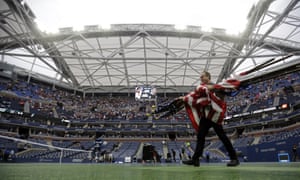Twenty years ago, Arthur Ashe Stadium opened as the centerpiece of the USTA’s National Tennis Center with a stirring dedication ceremony headlined by Whitney Houston. It’s been mostly downhill from there.
Aerial shots of the US Open’s octagonally shaped main show court have become a signal of New York City glamor beamed round the world. But while the pictures may look attractive to the millions who will never get the chance to attend the season’s final grand slam in person, the real-life experience is anything but. Clumsy design, tepid atmosphere and just plain bad luck have all conspired to hasten Ashe’s life cycle from sparkling newcomer to loathsome dinosaur. Two decades on, it endures as the worst major sports venue in America.
Any criticism of Ashe will start with the size of the thing. The 22,547-seat behemoth is the largest purpose-built tennis stadium in the world – and it’s not particularly close. The upper bleachers are thrust even further above the court by a ring of 90 luxury boxes, so high that standard etiquette is no longer enforced and spectators are permitted to roam freely between and even during points. If you’re seated in the ominously designated Row Z in the upper promenade, situated a nosebleed-inducing 120 feet above the court, the match below is but a rumor.
Naturally, this embodiment of American excess was erected with a primary objective of printing money hand over fist and to that end it’s been wildly successful. The US Open makes no secret of the huge crowds it attracts: more than 700,000 fans generate ticket revenue of over $100m during the two-week tournament. But the fan experience at the principal show court, at least for those in my tax bracket, is as lousy as it gets for a major sporting event.
The worst kept secret among Open regulars is there’s really no reason to set foot in Ashe unless you’re left with no other choice. That’s especially true during the first week. Since the tournament prioritizes the biggest names for Ashe over the best match-ups, the opening days offer a virtually uninterrupted string of one-sided matches played out before two-thirds-empty crowds – all while the outer courts are a blur of thrilling upsets, breakout performances and evenly matched marathons. Watching a top-50 player from 20 feet away is a far more rewarding experience than watching a top-fiver obliterate some qualifier from a distance where you can hardly hear the ball come off the racket.

Failings that were noticeable in 1997 are doubly apparent today. With televisions at the tournament carrying 4K telecasts that are larger and clearer than ever, the temptation persists to post up at one of the many pop-up bars on the grounds and take in the match where you can actually see it. David Foster Wallace once famously compared the difference between watching tennis on TV and experiencing it live to the difference between porn and the “felt reality of human love”, but a three-setter in the promenade might give him reason to reconsider.
The arena was built for a cost of $254m at what’s now regarded as a high point in American stadium design. The retro-style triumph of Baltimore’s Oriole Park at Camden Yards represented a rejection of the multi-purpose, cookie-cutter stadiums of the 1970s like Cincinnati’s Riverfront Stadium, Philadelphia’s Veterans Stadium, Pittsburgh’s Three Rivers Stadium and the old Busch Stadium in St Louis. But although it opened five years after Oriole Park and several years before Pittsburgh’s PNC Park and San Francisco’s AT&T Park, Ashe seems to have taken no cues from the stylistic triumphs of its day, save for the brick base inspired by the Baltimore ballpark.
Retractable-roof stadiums were already on the scene when Ashe was commissioned during the mid-1990s, but no one anticipated how affordable and commonplace they would become in the years immediately following its opening. As a result, Ashe took on an anachronistic feel less than a decade after it went up. As if to underscore the bad timing, a comically unlucky run of weather and backlogged matches between 2008 and 2013 prompted six consecutive US Open men’s finals to be postponed from Sunday to Monday, moving the issue of a roof from wish list to must-have.
The USTA insisted for years that a roof over Ashe would be unfeasible, saying the surface area of the opening above Ashe was five times that of Wimbledon’s Centre Court, which introduced a retractable roof for the 2009 tournament. They’ve since reversed tack, green-lighting a $550m modernization campaign that’s introduced a now-functioning roof over Ashe. The requisite exoskeleton that now envelops the stadium somehow makes it less sightly.
Ashe does have its moments. Few thrills can match the electricity of a night match before a capacity crowd, which can produce the sort of white-hot wall of sound only heard at championship fights. And the surreal, only-in-New-York spectacle of matches that stretch past 2am before a few hundred sleepless fans, after the beer and concession stands have been shuttered, when security allows fans in the mezzanine to move down to the high-rent district.
But even a stopped clock is right twice a day.
The National Tennis Center, which doubles as the largest public tennis facility in the world, is more of a treasure than even many native New Yorkers appreciate. For 11 months out of the year, any weekend hacker can walk up and play on the same outer courts where the world’s best will vie for one of the sport’s four bedrock titles over the next fortnight. It’s just a shame the US Open shines despite and not because of its signature venue. We’re stuck with it now and there’s no turning back. But in the meantime, I’ll see you on the Grandstand.



